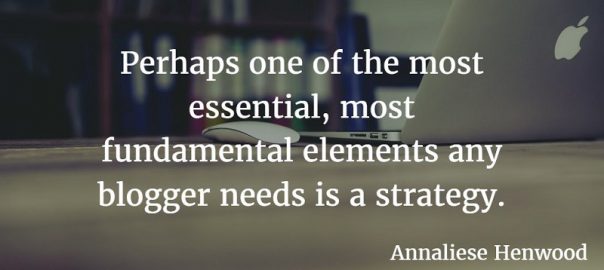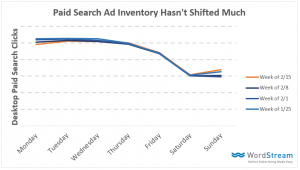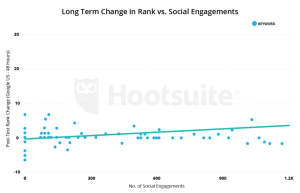October 6, 2016
Perhaps one of the most essential, most fundamental elements any blogger needs is a strategy. This isn’t a simple document you can rush through either. It’s an in-depth guide for all your future actions. It is not something you can ignore or go without if you want to reach your true potential.
Without a strategy, it’s as if you’re a wandering traveler without a map. A traveler without a purpose, memory, or destination in mind. It’s not the way you want to approach blogging.
Your strategy should answer all of the below questions as specifically as possible, even if it takes you a week or more to get through. Use Google Docs to collaborate with other people involved so that you can easily work together on this strategy. This will save you time and make collaboration a lot easier than if you keep sharing a Word document back and forth via email.

Now, these are the questions to ask yourself and your team:
Why are you doing this in the first place?
Use this space to write out your blog’s purpose or mission statement. It should only be a 1-2 sentences. Three at most. Your mission statement should look something like this in its simplest form:
Our blog [name] is about [overarching topic] aimed at helping [target audience] solve [their unique pain points].
Your mission statement should always include:
- The audience you’re targeting
- The content you’re publishing
- The benefits your content offers
What is your blog’s unique selling proposition (USP)?
How does your blog differ from the other sites out there in your industry? What are your key differentiators that you can highlight as your strengths? With a unique selling proposition or USP, you make it clear what your blog can include to increase influence. However, don’t let this limit you to just one strength. It’s only a starting point until you can answer more of the following questions.
What exists already and how has it done?
Assuming you’ve already been blogging for a while, consider doing a thorough audit of past content on your site. Which blog posts performed best in the last month (or year if you need more content to analyze)? Which topics performed best? Which author?
Once you know what was doing best, look at the opposite end: the worst performing content. Figure out why they underperformed so that you can learn from any mistakes. You don’t want to keep losing content because of these mistakes, so after you recognize the error, note it in your strategy so that it doesn’t happen again.
Although not necessary in your strategy itself, keep in mind that your past failed content can always be repurposed and updated into future content. It doesn’t have to be a complete loss.
Also, if you want to go even further, audit your distribution and promotion channels for their good and bad results and qualities. This will help you with later questions.
What do you want to happen?
This is such a key question to answer because it is pretty much the only way you’ll be able to proceed with your strategy, and even your blog as a whole.
Goals should be SMART:
Specific – Measurable – Attainable – Relevant – Time bound
On the other hand, you can also try CLEAR goal setting, which is a more agile approach for the modern era:
Collaborative – Limited – Emotional – Appreciable – Refinable
Whichever way you go, always write out your goals thoroughly and completely in your strategy document. Be open and prepared for updates.
Who are you writing your content for?
It’s important to note who you are creating content for within your strategy. These reader personas should be as clear and complete as the buyer personas you should already have established for your business.
If you’re blogging solo, this is a brief explanation of these reader personas: They should be fictional representations of who your target readers are. They aren’t meant to be real people but rather just examples of the type of people you’re targeting with your content.
Who is your current competition?
Knowing what you can about your competition, especially regarding their blog and its content, can give you an advantage. Even if they’re bigger and more successful than you are at present. Your strategy development is all about planning for the future, and you’ll always have an opportunity to get better than they are in one way or another.
These are just some of the key factors you need to evaluate from your competition to get a clear understanding for the future:
- What do they currently offer on their blog, including topics and content types?
- What do they do well?
- What are they missing that you can offer?
- Who is their audience?
- How do you differ from them in good and bad qualities?
Ignoring your competition creates a big missed opportunity for you, so don’t make that mistake. Use tools like SEMrush or Buzzsumo for competitor research and analysis. They are both great resources to save you time and effort for this essential part of your strategy.
How often will you publish content?
In this section, include your ideal publishing schedule. When I say “ideal,” I mean it’s something you should aim for but not set in stone. You should think this through before making a scheduling decision because it needs to be something you can maintain from the beginning and consistently.
This is not the place for a full-on calendar. It’s a place to briefly explain the frequency in which you will publish each type of content for your blog. See the part about “each type?” That’s right. You should mention a publishing schedule for blog posts, videos, eBooks… Any and all content types that will appear on your site.
What types of content will you offer?
On that note, this is where you’ll list all the different content types you’ll produce in the future. Don’t include past content types you’re abandoning. This space is just for future activity.
Some examples of content types you might include are:
- Long-form posts
- Videos
- Presentations
- eBooks
- Infographics
Your blog should have a variety of content, and this is the place to list them all.
What topics will you focus on?
When you have a blog, you can’t just write about anything and everything if you want to build a loyal audience. You need to have a focus, such as an industry or interest area.
This is just one of the ways you can narrow down your topics into a more manageable focus:
- Start by collecting all your blog content headlines and keywords.
- Write out all the subtopics that you find in your content headlines.
- Write out all the topics that you find within your list of keywords.
- Add any of the tags and categories from your blog that haven’t already been added.
- Review this full list and remove the bottom half, least often used topics.
- Review what you have left, and find the overarching theme for those topics.
- Choose that theme as the main topic for your blog.
When you know the 1-2 main topics for your blog, you can better select the few subtopics to include. You don’t want more than 5-7 subtopics or categories for your blog because you want to maintain that loyal audience.
Here’s an example from my own blog:
Main theme = marketing
Subtopics = blogging, content marketing, email marketing, social media marketing, personal branding, writing, general marketing, productivity
As you can see, I have an outlier in that list of subtopics: productivity. I admit, it doesn’t fit with the rest of the topics and certainly doesn’t relate well to the main theme. It’s something I did notice, so I’ve stopped writing those articles. If you have past content that won’t be relevant anymore after this strategy is complete, you don’t have to delete all your work. It’s enough to just stop creating those articles in the future.
Where will you distribute your content?
It’s obvious that your content will appear first on your blog, but have you considered where else it can be shared? You have options, and these are just two that I recommend most:
Syndication
When you want an automatic service to share your blog content elsewhere after you hit publish, consider syndication. This can be done via RSS feed, such as what I do with Business 2 Community. It’s an easy way to get more exposure for your content than if you only had your blog alone.
Kristi Hines of Wagepoint put together a list of syndication sites that you should check out if you need help finding places for your content.
Put together your own list of syndication sites that would work well for your content type, and add that list to your strategy.
Guest blogging
It’s best practice to write original content for guest blog sites, and that’s what I recommend you do most of the time. However, it doesn’t always have to be that way. If you have content that is truly valuable and has high potential for the 3rd-party site’s audience, send them a pitch telling them exactly that.
Guest blogging has so many benefits, so it would help to include a list of potential opportunities in your blog strategy for future reference.
Other options you have for content distribution include:
- LinkedIn Pulse
- SlideShare
- YouTube
- Online forums
How will you promote your content?
Similar to content distribution, content promotion is an essential way to get your blog in front of your target audience more than if you didn’t do it at all. You have so many options, too:
- Social media
- Email outreach
- Influencer outreach
- Advertising
First, social media content promotion is probably the most common way to get your content out there. The many social platforms each have large audiences that consume content in unbelievably large quantities every day. It’s a great opportunity for you to get more traffic to your own blog, when it’s done correctly. An important tip to keep in mind is that you should always customize your message for the platform and its audience. If the content doesn’t fit that audience, don’t share it there. Find the right platform with the right audience before spending time promoting.
Email outreach is also a big way to get your content in front of the right people. As long as you’re segmenting and personalizing effectively, email outreach can be highly successful for lead nurturing. You can find out more about how to use email marketing effectively in my free guide. An important tip is that your content isn’t for everyone on your list and should only go to those contacts who would want it. Otherwise, you’re essentially spamming people.
Influencer outreach is a more general way to get your content to a larger audience, but you have less control over who sees and uses it. You should research the right influencers and have worthwhile content to share before starting this outreach. You’ve spent the time creating content you want people to see, and reaching out to influencers is a great way to get mass exposure for it.
Lastly, advertising is the more costly yet still effective way to get your content right to your target audience’s front door. You can advertise on social media, using the advanced settings to target specific groups of people, or you can use search engines, such as Google’s AdWords, to get found higher in search results. Although this obviously means you’ll be paying for exposure, this approach is the best way to control who sees your promotional tactics. If you want everyone of a specific trait and location to see your content, use online advertising to get it to them.
What will you need to achieve your goals?
This is a tough one to explain because it really depends on what your goals are. However, I’ve listed a few tools that could potentially be of value to you as you build and act on your strategy. I mentioned SEMrush before, so I won’t add it again here. I highly recommend it though.
Google Keyword Planner
Although it requires an AdWords account, which is annoying, this is the standard way to research keywords for Google search. It’s Google’s own tool, so it gives you clear insight into what keywords people are using in search. It’s a bit limited and slightly hard to work with compared to some of the 3rd-party alternatives, but if you have an AdWords account, this is the best option. It’s both free and provides the information you’re looking for.
Google Docs, Sheets and Slides
Pretty much any of Google’s organization tools are great for strategy and content development because of the easy collaboration they provide. In Google Docs, you can work together with others in real-time, adding comments, making suggested changes, using other add-ons. It’s a lot better than emailing back and forth and meeting in person over and over again.
Google Analytics
You need to use this tool. It’s not even an option to ignore it because it’s the leading tool for its purpose by far. When you want to do the audit of your past content or want to see the impact your new content has later, use Google Analytics. It provides all the information from your site that you’ll need in order to make informed decisions in the future. One tip: set goals in Analytics to automatically see whether your activity succeeds in achieving them.
CoSchedule
There’s no point in just writing randomly whenever you feel like it without any direction. It’s sloppy and limits your impact. You need a calendar that works with you without getting in the way. A simple Excel sheet isn’t enough. That’s why I recommend CoSchedule. They offer to do the work for you to make the writing process seamless for you. Although I’ve found them a bit pricey and hard to get used to using, their success rate is hard to ignore.
MailChimp
This is hands-down the best option out of all the email marketing tools out there. Why? Because it doesn’t cost a fortune yet still offers everything you need to send your content to your subscribers. When you’re a blogger, you don’t need intense software that will kill the bank. Instead, use MailChimp because it has more than enough features for content promotion.
List the needs you have for your blogging process – every step of the way – and find the best tool for each. This will all depend on your specific needs and budget. Once you know what you’ll need and how you can get it, you’ll be better prepared to handle it.
How will you measure success?
Earlier on in this strategy development process, you established what you hope to achieve with your blogging (your goals). Now, it’s time to write out how you will determine whether you’ve succeeded.
Dig deep into your goals and determine what metrics will explain whether you’ve reached them. If your goal is lead generation, track the metrics around your web forms. Where were they when they filled out the form to become a lead? How many people abandoned your site prematurely and why? Using Google Analytics can guide you towards finding the KPIs that’ll help you confirm results.
Be sure to have metrics established for every one of your goals in full. The more specific you are, the better chances you have at reaping the rewards of your hard work.
Who will be involved at each stage of the process?
Perhaps this could come sooner, but the last part of your strategy that I mention is team building. This is where you assign a person to each task involved throughout the process – from inception to measurement and back again. This is all unless you’re blogging solo, of course, but even then, you can still divide your time as if each hour is a different person.
Have Mary be in charge of the calendar.
Have Sam be in charge of writing for a specific topic.
Have Lisa be in charge of publishing the content online.
Have Amanda be in charge of social media promotion…
Have yourself be in charge of managing it all.
Alternatively, if blogging solo, change the names to a time block on your calendar. If Mary’s work is now 2pm to 4pm, you’d work on your content calendar during that time.
———
You’ll find that there’s probably more that you can add to your strategy, depending on your business or blog’s purpose and activity. It also depends on whether you’re a blogging novice or blog master. If the latter, I’m honored you’re here reading this.
I wish you the best as you create your own content strategy!
Business & Finance Articles on Business 2 Community(73)




